This project aiming at unravelling the undiscover phytochemistry of four endemic taxa including Quercus alnifolia, Bosea cypria, Hypericum repens, Onosma troodi and their beneficial properties, not only as pharmaceuticals in medicine but also as biostimulants in agriculture.
Quercus alnifolia Poech
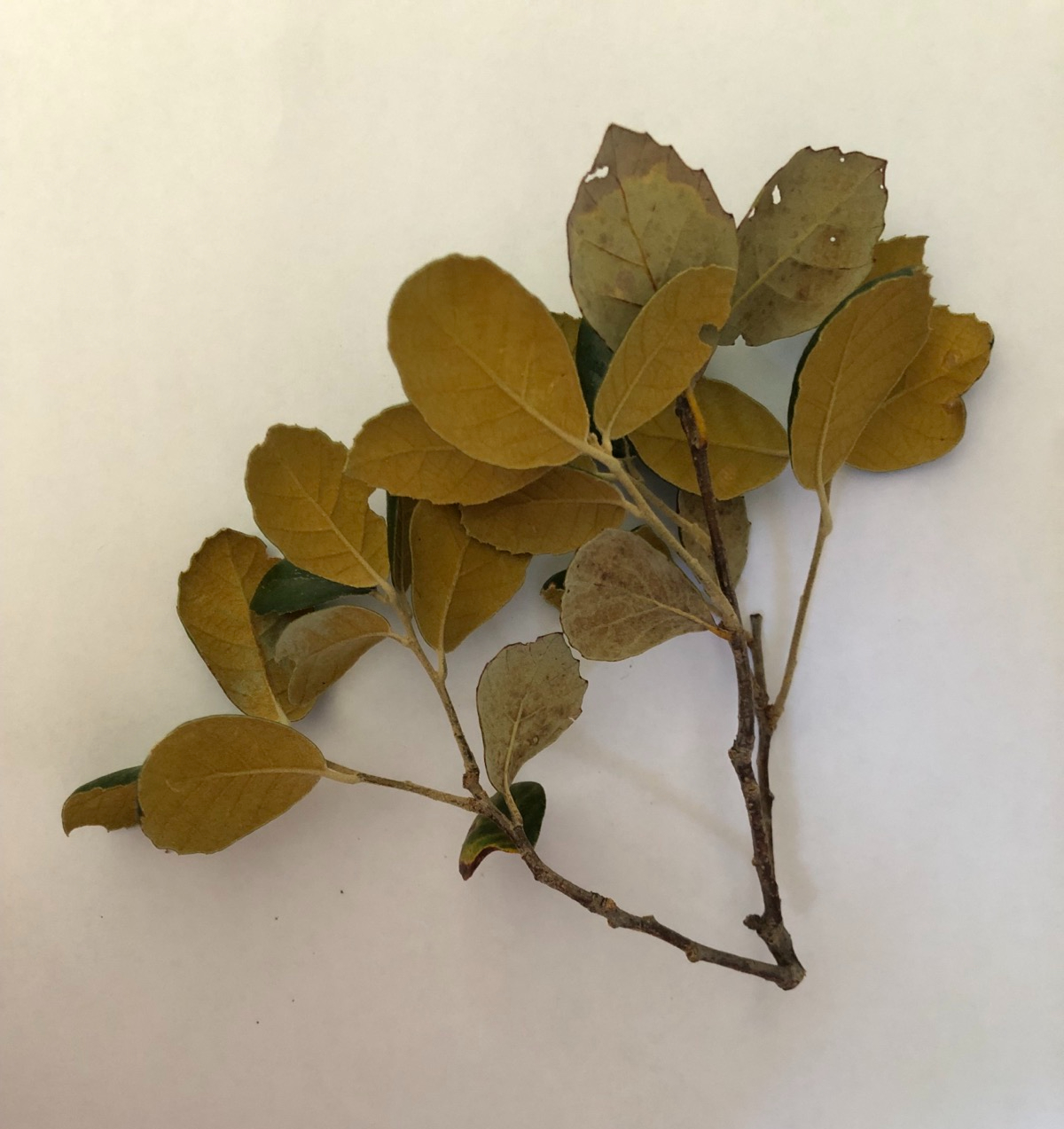




Quercus alnifolia is an endemic oak species of Cyprus. The local name transliterates from Greek Cypriot dialect into “Latzia”. It can be found exclusively on the mountain region of Troodos on ultrabasic rock formations1. Q. alnifolia sprouts on a height between 400 to 1800 meters, where it forms forests of shrubs or trees up to 12 meters tall. Alternatively, it can grow as understorey to other trees like the Pinus spp.2. Taxonomically, it is considered member of the Fagaceae family, and is morphologically and genetically distinct from other related species. Q. alnifolia leaves have a characteristic colouring that give to the species the common name “Golden oak”. Especially the young leaves have on their abaxial surface a golden hue, while the adaxial surface is dark green. The existed published studies focus on its morphological and genetic characteristics1,2,3,4. Remarkably, there is no available research on this species regarding its phytochemical composition and the potential properties of its extracts. Although, on several species of the genus Quercus, the research worldwide showed significant amounts of phenolics like gallic acid5, tannins6,7, flavonoids such as epicatechin8, and antioxidant activity in extracts produced by different parts of the plant, such as the bark, galls, and leaves using a variety of extraction methods. Some of these studies also investigated the antimicrobial9, anticancer10,11 and other properties12, with promising findings.
Bosea cypria Schinz & Autran
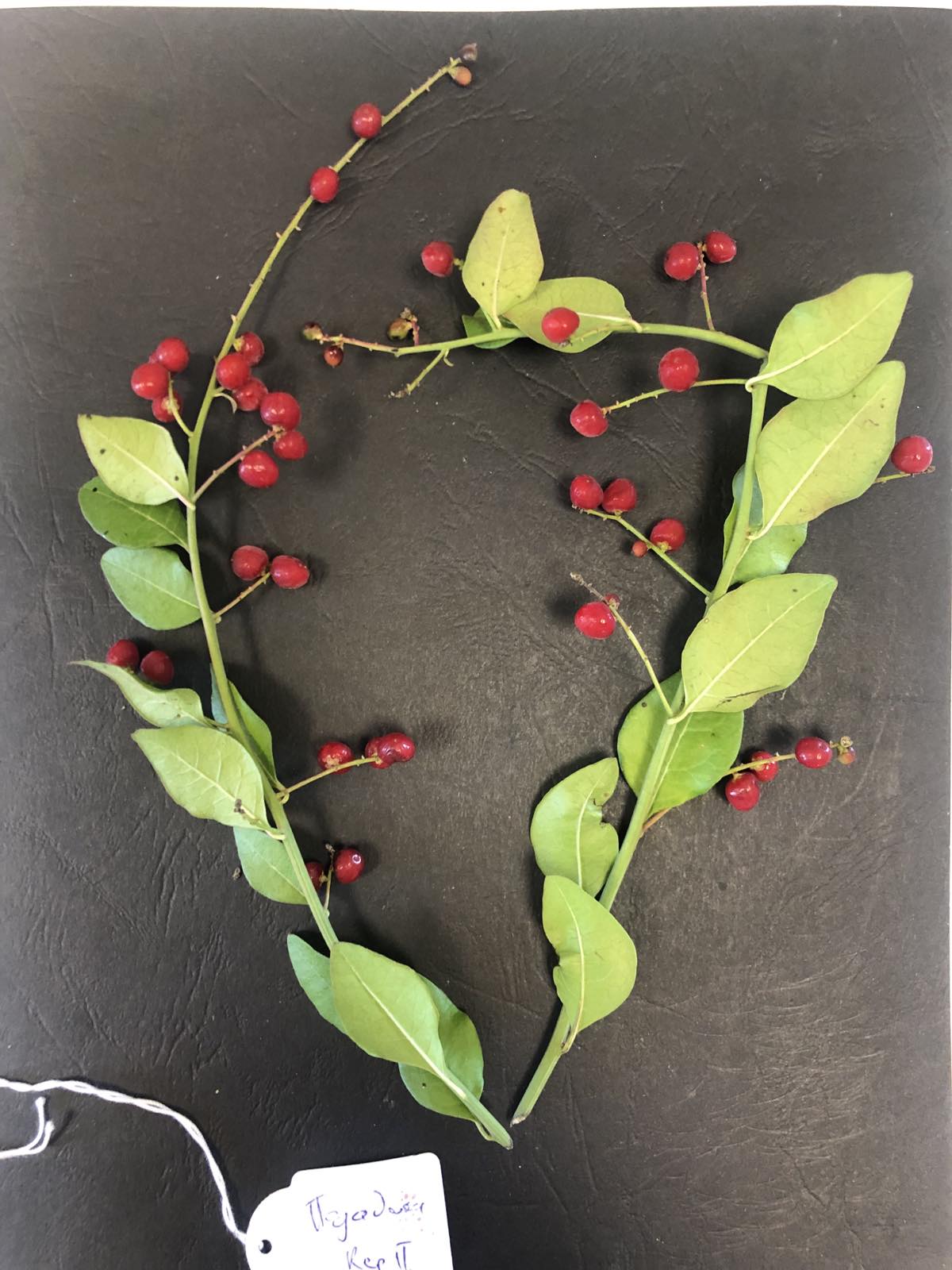




Bosea cypria, or “Zoulatzia” as it locally called13, is an endemic species of evergreen shrub in Cyprus. It occurs on rocky ground, stone walls, or rocky sites with open or maquis vegetation from the sea level up to 650 m altitude14. Its height varies around 1-2 m14 and it is intricately branched15. It produces small flowers between April to July, which give red globose berries, 4-5 mm in diameter, with a large seed inside15. B. cypria belongs to the Amaranthaceae family and itis one of the only three species of the genus Bosea occurring worldwide14. The other two are also endemic and they can be found in geographically separated areas, in Canary Islands (B. yervamora) and in N.W. Himalayas (B. amherstiana)15. Regarding B. cypria, testimonies from the locals mention usage of the species in the olden days as a painting dye (from the fruit) and possibly foraging source for birds. According to a study Bosea cypria can survive under high copper content soil from mine waste with the possibility of phytoremediation of the polluted soil via phytoextraction (metal accumulation in the plant’s leaves)16. Remarkably, up to now there is no published research regarding the chemical composition and the properties that the species could be possess. The presence of the red colour throughout the whole plant (stem, leaves, fruit) suggests the accumulation of anthocyanins. Work on B. yervamora shows that its fruits contain the sugars glucose, fructose, sucrose, raffinose, and stachyose and fatty acids with highest percentage of palmitic, stearic, and oleic acids17. Testing with extracts of B. amherstiana indicates noticeable anti-inflammatory, analgesic, anti-pyretic effects in non-toxic doses18 and potential prevention of oxidation damage19. It becomes obvious that we might miss important information with no further studies on our native species.
Hypericum repens L.
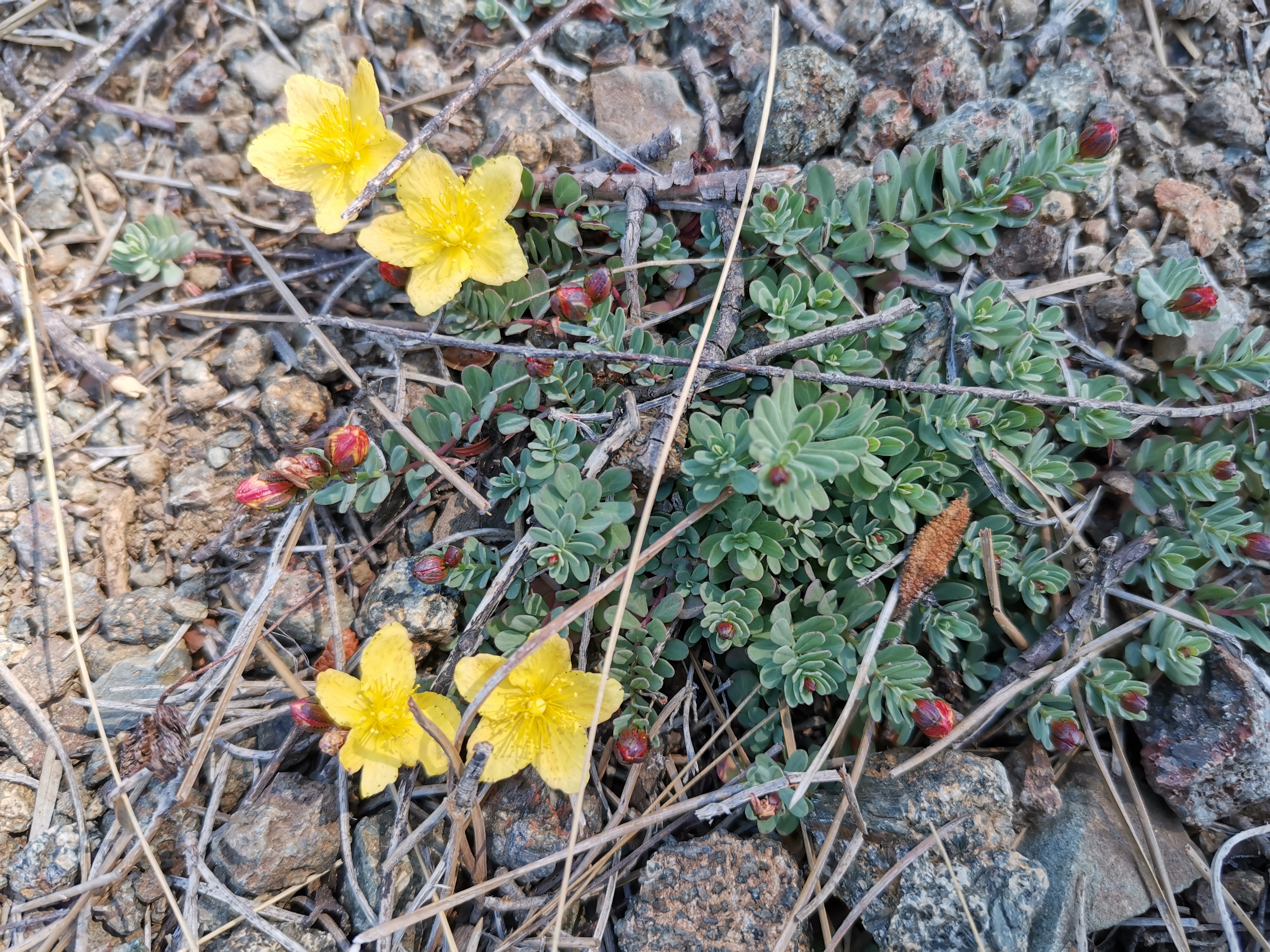
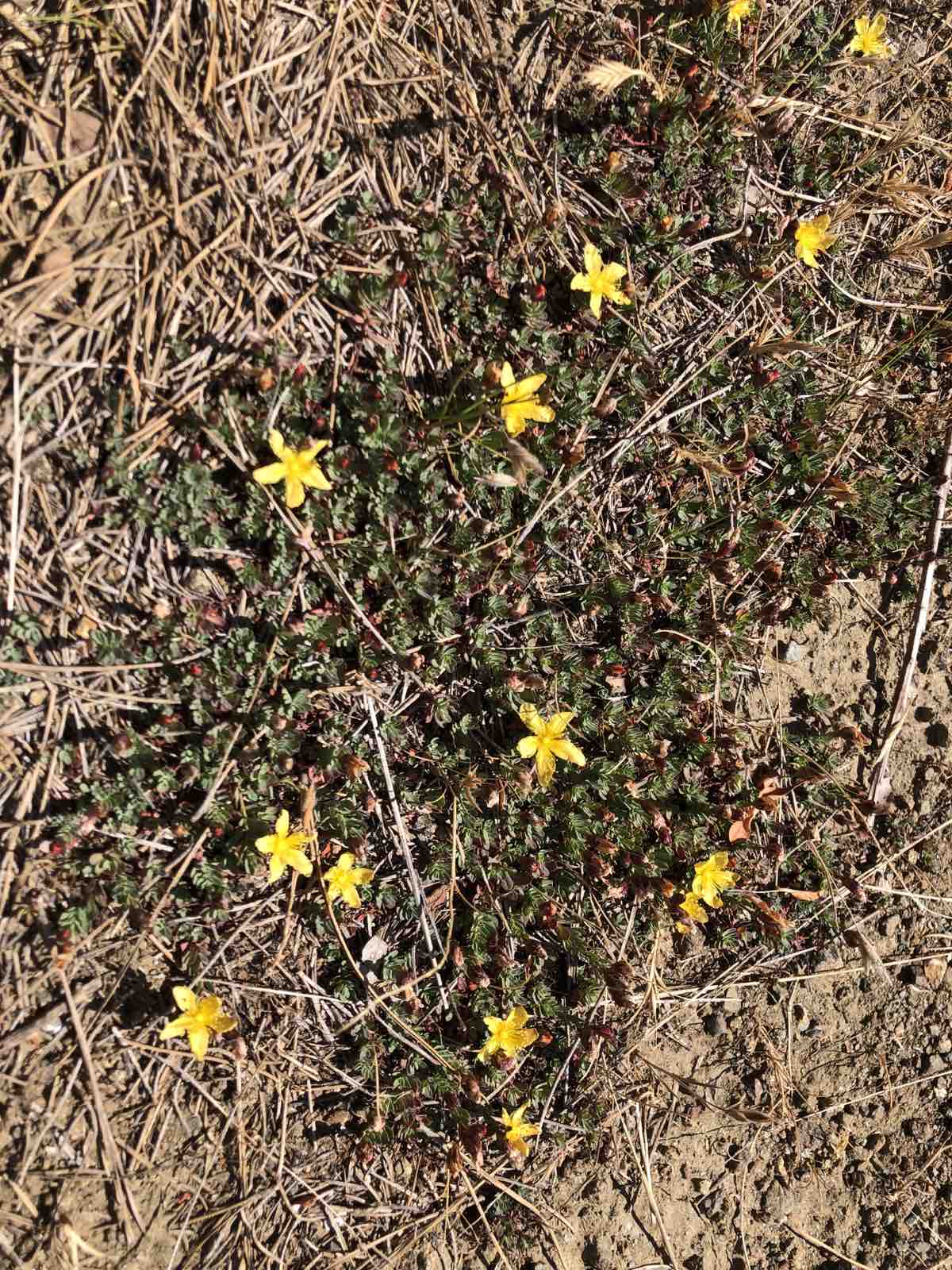
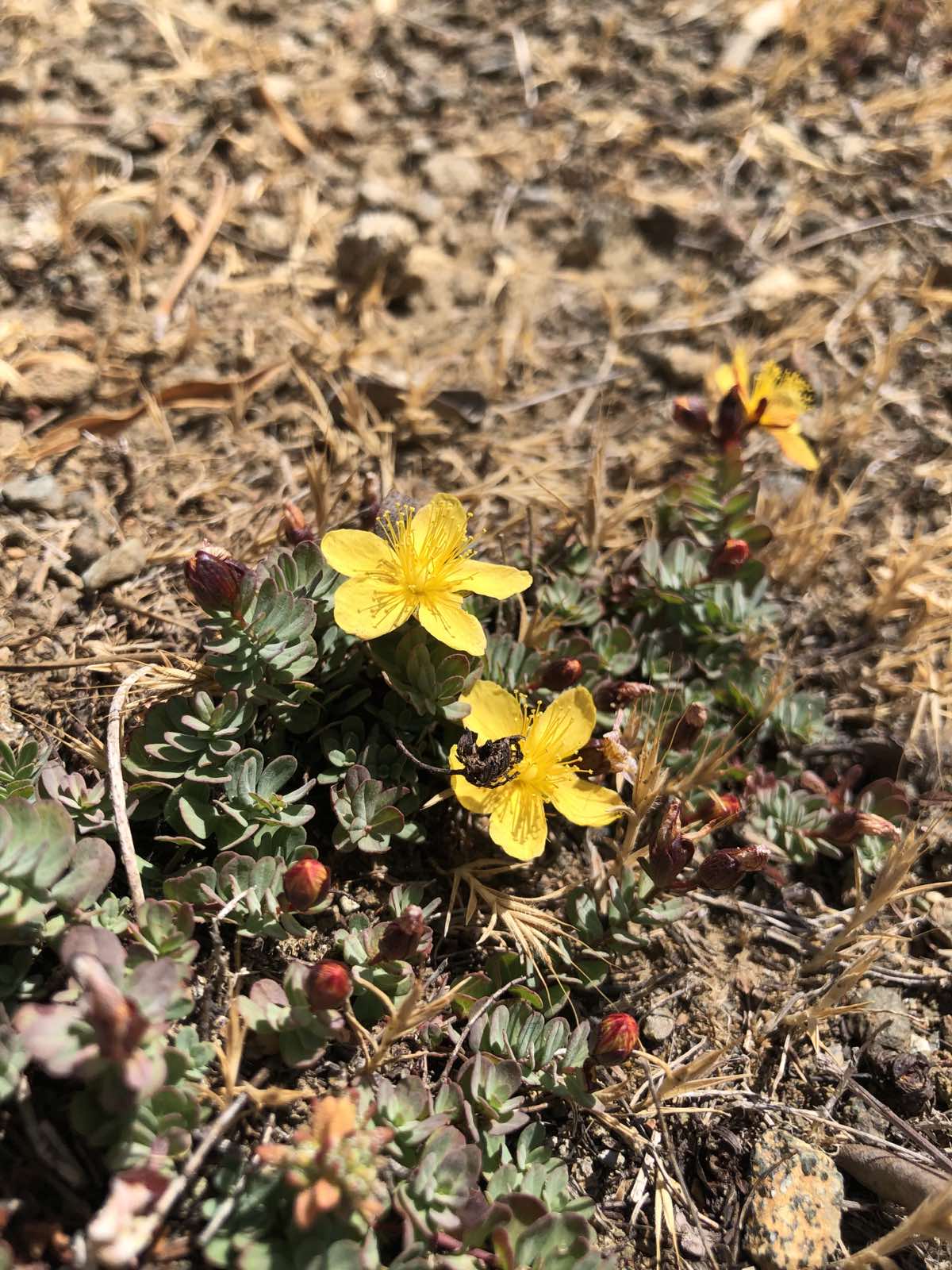
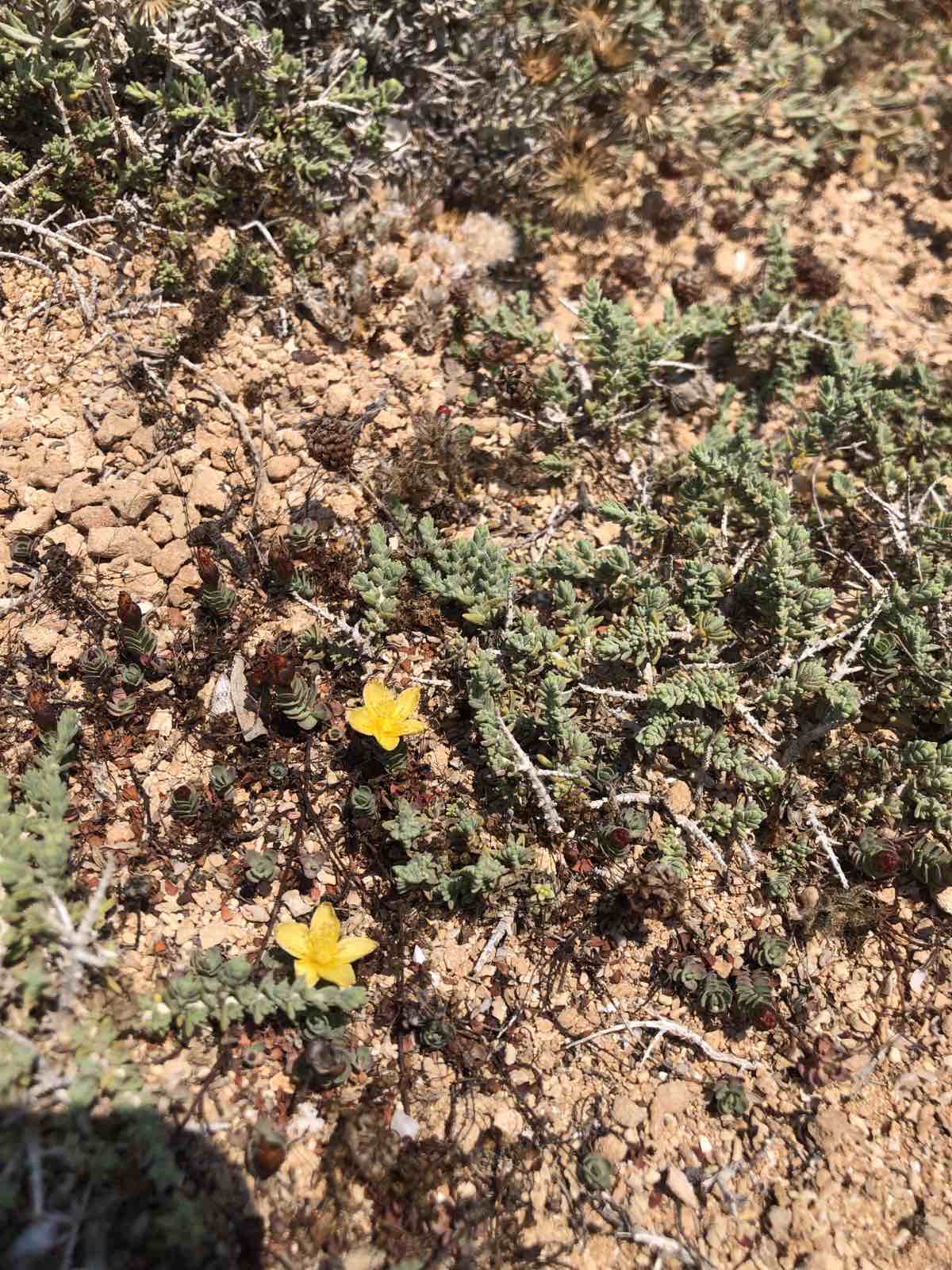

Hypericum repens is a perennial herb, native and naturally occurring in Cyprus on dry stony ground and grazed pastures20. It grows up to a length of 20 cm, from sea level to altitudes almost 1500 m high, in an area covering the island from North to South between Kerynia-Nicosia-Troodos-Limassol, excluding the areas of Morphou, Rizokarpaso and the other major cities. It is classified as a member of Hypericaceae family13. There are 7 more Hypericum spp. indigenous to Cyprus, though not endemic, like the well-known H. perforatum, “Varsamochorton” as is often called by Greek Cypriot populations. H. repens morphology is distinct from the other relative species due to its prostrate or ascending and rooting stems, the oblanceolate-spathulate leaves of 5-7 mm long and the styles that are usually 5 or rarely 320. In addition, it has small leaves and proportionally larger flowers. Its flower buds are red but when they bloom from May to July reveal a dominant yellow colour on its numerous stamens and petals. The petals carry red veins, pellucid dots and streaks and marginal black dots. These glands are also present on other parts of the plant, like sepals and leaves. Translucent glands are very well known in Hypericum spp. due to their content in essential oils and hypericin20. Hypericin is a naphthodianthrone which together with hyperforin is one of the principal bioactive compounds present in Hypericum spp., that is being extensively studied in the process of uncovering the mechanisms behind its antidepressant properties21. Moreover, a great number of research has been conducted to unravel other potential properties of Hypercum spp., like wound healing22, antimicrobial activity23,24 and anticancer properties with promising results. Despite the abundance of studies on the genus, there is absence of data regarding H. repens.
Onosma troodi Kotschy
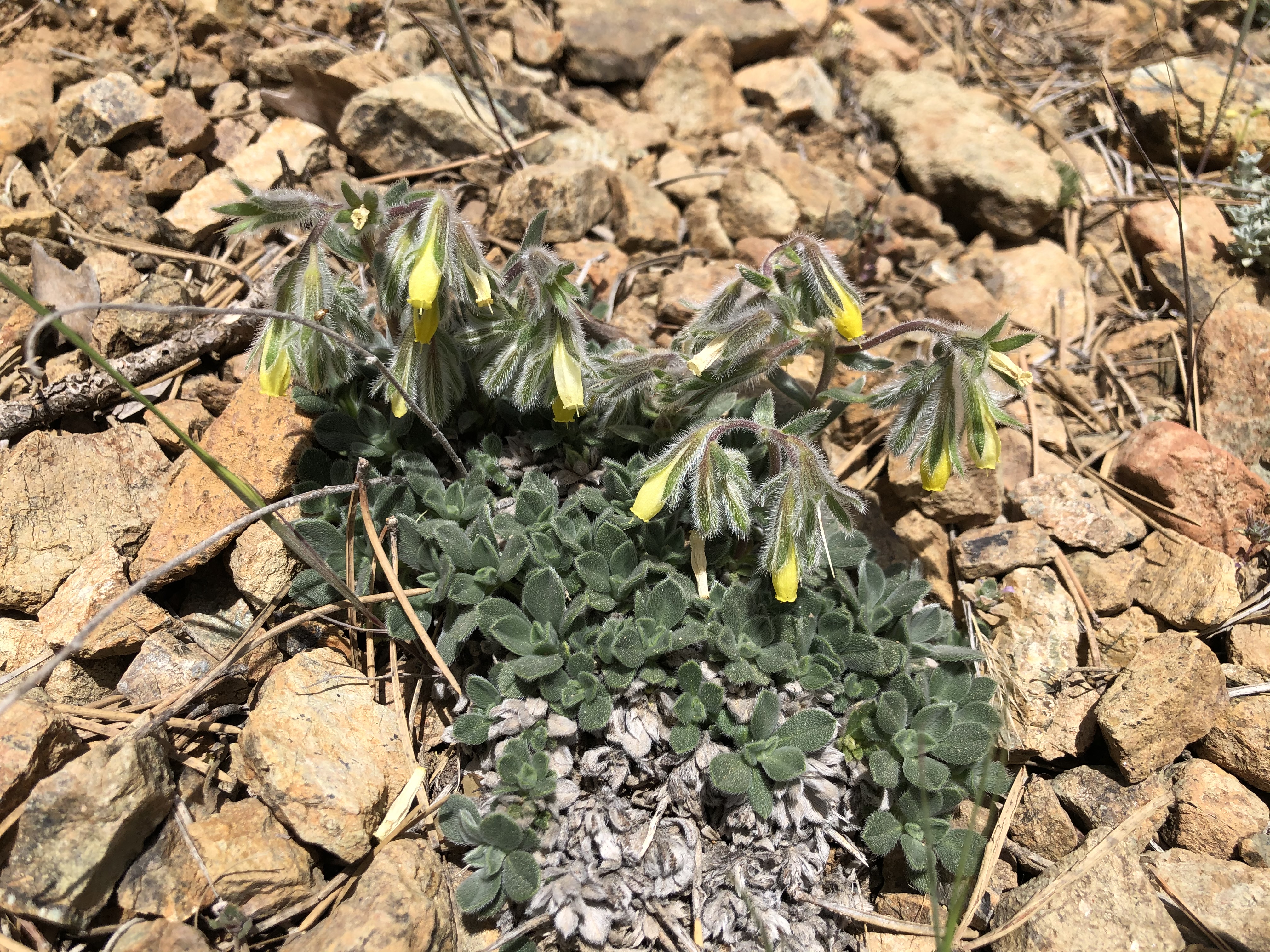
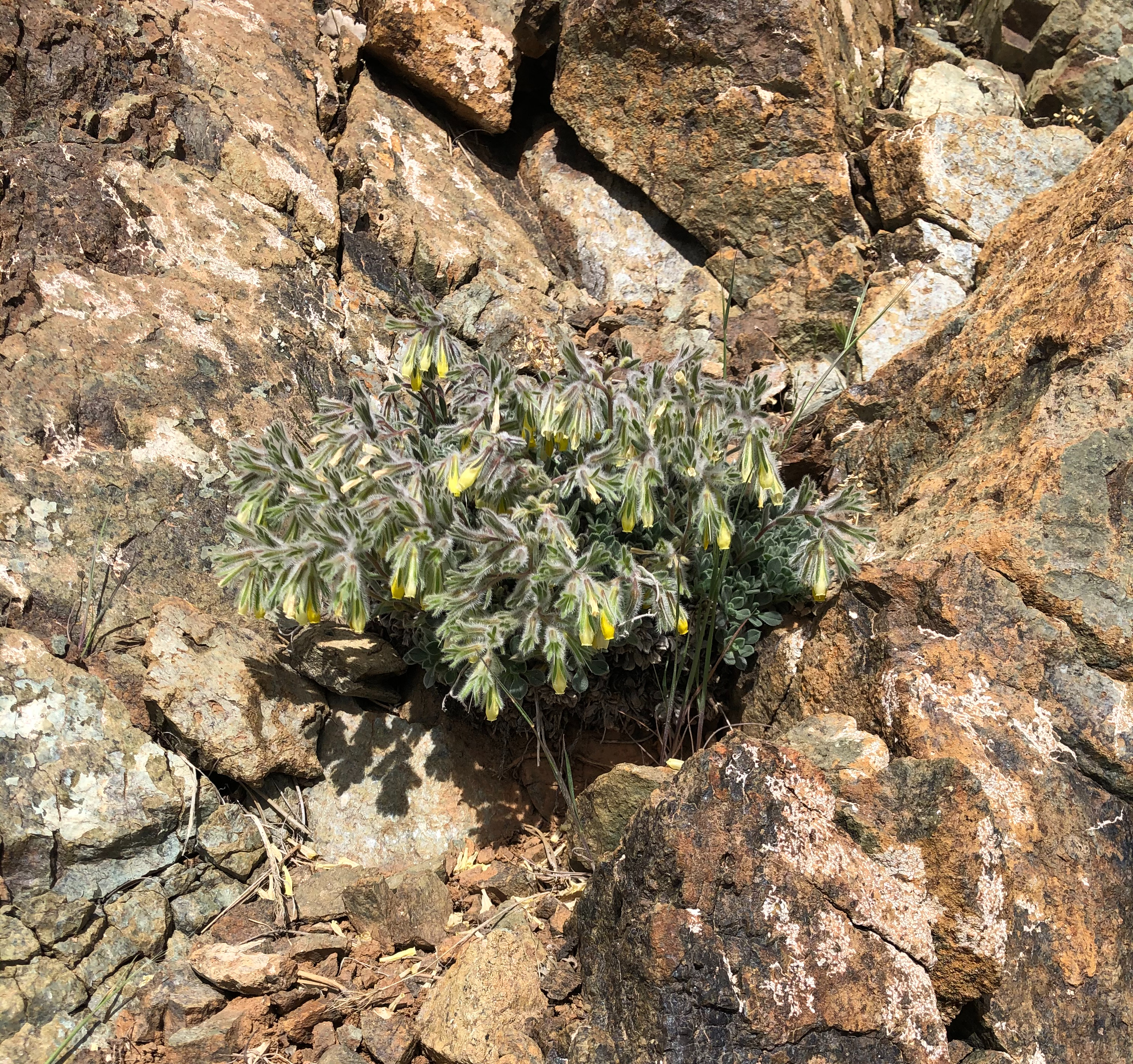

Onosma troodi Kotschy is a tufted perennial plant endemic to Cyprus. It sprouts on rocky slopes on Troodos Mountain between 1585 m and 1950 m and reaches the height of 15-20 cm13,15. Rarely can be found on diabase or gabbro between 1035 m and 1465 m. Taxonomically is part of the Boraginaceae family15. There are 5 more indigenous species of the Onosma genus present on the island. O. troodi consider vulnerable species and it is included in the Red Data Book of Flora of Cyprus13. O. troodi can be recognized separately from the other species, as it has basal leaves that are crowded, rosulate and spathulate, 10-20 mm long and 4-8 mm wide. When it is flowering in April to June, it produces flowers with yellow corolla, narrowly cylindrical or sub-fusiform15. The whole body of the plant is covered with hair. There are no published papers found concerning its chemical composition and medicinal properties. The Onosma genus includes about 150 species, around Asia, Europe and Mediterranean regions, with few of them studied in some extend. Regarding the phytochemistry and ethnopharmacology, the genus comprises mainly aliphatic ketones, lipids, naphthazarins, alkaloids, phenolic compounds, naphthoquinones, and flavones (shikonins and onosmins). Individual Onosma spp. and their phytochemicals have been studied for their antioxidant, anti-inflammatory, analgetic, antimicrobial, antiulcer and other activity with promising results. Traditionally, these plants are used in various occasions. For example, flowers are used as a cardiac tonic and stimulant, leaves are used as purgative and roots to treat wounds and to produce a coloring agent due to the presence of a red dye25. There is fertile ground for the study of Cyprus’ endemic species, O. troodi.
References
1 Neophytou, C., Palli, G., Dounavi, A. and Aravanopoulos, F.A., 2007. Morphological differentiation and hybridization between Quercus alnifolia poech and Quercus coccifera L. (Fagaceae) in Cyprus. Silvae Genetica, 56(6), pp.271–277. https://doi.org/10.1515/sg-2007-0038.
2 Petrou, P., Kitikidou, K., Milios, E., Koletta, J. and Mavroyiakoumos, A., 2015. Curvas de índice de sitio para la especie roble dorado (Quercus alnifolia). Bosque, 36(3), pp.497–503. https://doi.org/10.4067/S0717-92002015000300016.
3 Neophytou, C., Aravanopoulos, F.A., Fink, S. and Dounavi, A., 2011a. Interfertile oaks in an island environment. II. Limited hybridization between Quercus alnifolia Poech and Q. coccifera L. in a mixed stand. European Journal of Forest Research, 130(4), pp.623–635. https://doi.org/10.1007/s10342-010-0454-4.
4 Neophytou, C., Dounavi, A., Fink, S. and Aravanopoulos, F.A., 2011b. Interfertile oaks in an island environment: I. High nuclear genetic differentiation and high degree of chloroplast DNA sharing between Q. alnifolia and Q. coccifera in Cyprus. A multipopulation study. European Journal of Forest Research, 130(4), pp.543–555. https://doi.org/10.1007/s10342-010-0442-8.
5 di Maria, F., Segoloni, E. and Lavagnolo, M.C., 2020. Extraction of Bio-chemicals for Pharmaceutical and Food Industry from Myrocarpus frondosus, Robinia presudoacacia and Three Quercus Species. Waste and Biomass Valorization, [online] 11(5), pp.2059–2065. https://doi.org/10.1007/s12649-018-0469-5.
6 Top, S.M., Preston, C.M., Dukes, J.S. and Tharayil, N., 2017. Climate influences the content and chemical composition of foliar tannins in green and senesced tissues of Quercus rubra. Frontiers in Plant Science, 8(May). https://doi.org/10.3389/fpls.2017.00423.
7 Iylia Arina, M.Z. and Harisun, Y., 2019. Effect of extraction temperatures on tannin content and antioxidant activity of Quercus infectoria (Manjakani). Biocatalysis and Agricultural Biotechnology, [online] 19, p.101104. https://doi.org/10.1016/j.bcab.2019.101104.
8 Brossa, R., Casals, I., Pintó-Marijuan, M. and Fleck, I., 2009. Leaf flavonoid content in Quercus ilex L. resprouts and its seasonal variation. Trees – Structure and Function, 23(2), pp.401–408. https://doi.org/10.1007/s00468-008-0289-5.
9 Elansary, H., Szopa, A., Kubica, P., Mahmoud, E., Ekiert, H., Yessoufou, K. and Zin El-Abedin, T., 2019. Medicinal Compounds of Quercus Bark and Related Agricultural and Pharmaceutical Applications. Arab Universities Journal of Agricultural Sciences, 27(1), pp.699–706. https://doi.org/10.21608/ajs.2019.43687.
10 Rehman, M.U., Tahir, M., Ali, F., Qamar, W., Khan, R., Khan, A.Q., Lateef, A., Oday-O-Hamiza and Sultana, S., 2012. Chemopreventive effect of quercus infectoria against chemically induced renal toxicity and carcinogenesis. International Journal of Drug Development and Research, 4(2), pp.336–351.
11 Moradi, M. taghi, Karimi, A. and Alidadi, S., 2016. In vitro antiproliferative and apoptosis-inducing activities of crude ethyle alcohole extract of Quercus brantii L. acorn and subsequent fractions. Chinese Journal of Natural Medicines, [online] 14(3), pp.196–202. https://doi.org/10.1016/S1875-5364(16)30016-4.
12 Custódio, L., Patarra, J., Alberício, F., Neng, N.R., Nogueira, J.M.F. and Romano, A., 2013. Extracts from Quercus sp. acorns exhibit in vitro neuroprotective features through inhibition of cholinesterase and protection of the human dopaminergic cell line SH-SY5Y from hydrogen peroxide-induced cytotoxicity. Industrial Crops and Products, [online] 45, pp.114–120. https://doi.org/10.1016/j.indcrop.2012.12.011.
13 Anon. 2022. Flora of Cyprus. [online] Available at: <https://www.flora-of-cyprus.eu/> [Accessed 19 September 2022].
14 Crivellaro, A. and Schweingruber, F.H., 2013. Atlas of Wood, Bark and Pith Anatomy of Eastern Mediterranean Trees and Shrubs. Springer Heidelberg New York Dordrecht London. https://doi.org/10.1007/978-3-642-37235-3.
15 Meikle, R.D., 1985. Flora of Cyprus Vol.2. Bentham-Moxon Trust, Royal Botanic Gardens, Kew.
16 Johansson, L., Xydas, C., Messios, N., Stoltz, E. and Greger, M., 2005. Growth and Cu accumulation by plants grown on Cu containing mine tailings in Cyprus. Applied Geochemistry, 20(1), pp.101–107. https://doi.org/10.1016/j.apgeochem.2004.07.003.
17 Kull, U. and Kuhn, B., 1978. On some constituents of Bosea yervamora fruits. Vieraea, 8(1), pp.187–190.
18 Hassan, S., Ahmad, B., Khan, S.U., Linfang, H., Anjum, S.I., Ansari, M.J., Rahman, K., Ahmad, I., Khan, W.U., Qamar, R., Man, S., Nabi, G. and Shah, A.H., 2019a. In vivo pharmacological investigation of Monotheca buxifolia and Bosea amherstiana using animal models. Saudi Journal of Biological Sciences, [online] 26(7), pp.1602–1606. https://doi.org/10.1016/j.sjbs.2018.10.008.
19 Hassan, S., Ahmad, B., Shah, J., Bashir, S., Jahan, S. and Hizbullah, 2019b. Protective role of Monotheca buxifolia and Bosea amherstiana against H 2 O 2 -induced DNA damage in human lymphocytes and its effect on oxidative enzymes. Pakistan Journal of Pharmaceutical Sciences, 32(2), pp.601–606.
20 Meikle, R.D., 1977. Flora of Cyprus Vol.1. Bentham-Moxon Trust, Royal Botanic Gardens, Kew.
21 Mennini, T. and Gobbi, M., 2004. The antidepressant mechanism of Hypericum perforatum. Life Sciences, 75(9), pp.1021–1027. https://doi.org/10.1016/j.lfs.2004.04.005.
22 Süntar, I.P., Akkol, E.K., Yilmazer, D., Baykal, T., Kirmizibekmez, H., Alper, M. and Yeşilada, E., 2010. Investigations on the in vivo wound healing potential of Hypericum perforatum L. Journal of Ethnopharmacology, 127(2), pp.468–477. https://doi.org/10.1016/j.jep.2009.10.011.
23 Saddiqe, Z., Naeem, I. and Maimoona, A., 2010. A review of the antibacterial activity of Hypericum perforatum L. Journal of Ethnopharmacology, [online] 131(3), pp.511–521. https://doi.org/10.1016/j.jep.2010.07.034.
24 Agnol, R.D., Ferraz, A., Bernardi, A.P., Albring, D., Nör, C., Sarmento, L., Lamb, L., Hass, M., Poser, G. von and Schapoval, E.E.S., 2003. Antimicrobial activity of some Hypericum species. Phytomedicine, 10, pp.511–516.
25 Kumar, N., Kumar, R. and Kishore, K., 2013. Onosma L.: A review of phytochemistry and ethnopharmacology. Pharmacognosy Reviews, 7(14), pp.140–151. https://doi.org/10.4103/0973-7847.120513.